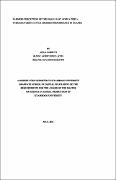| dc.description.abstract | The study aimed to determine the performance of the Small East African Zebu (SEAZ) and the
Tyrolean Grey cattle crosses (TGX) in the selected cattle corridor districts (Kole, Nakapiripirit, and
Kayunga of Uganda. SEAZ is an indigenous breed in Uganda, while the TG breed is indigenous to
the alpine region of Austria and was introduced in the country through use of semen in 2009. Heart
girth data collected for over three years at Lusenke Stock Farm (National Animal Genetic Resources
Centre and Databank – NAGRC&DB) was used in the study. This study used cross-sectional survey
design embracing qualitative and quantitative approaches. Data was obtained by use of structured
questionnaires, focus group discussion, and Individual In-depth interview for farmers, AI technicians,
farm managers and extension workers. The study revealed that, traits such as; better draft power
(χ2=6.943, p<0.01) and resistance to parasites and diseases (χ2=4.477, p<0.05) were significantly
associated with the SEAZ. On the other hand, docility (χ2=4.847, p<0.05), better milker (χ2=13.976,
p<0.001), good mothering ability (χ2=10.174, p<0.001), fast growth (χ2=11.242, p<0.001) and hard
hooves to withstand muddy places better (χ2=4.498, p<0.05), were significantly associated with the
TGX. The study established that, the TGX were majorly and significantly constrained by parasites
and diseases (χ2=7.967, p<0.05), shortage of feeds and grazing land (χ2=5.946, p<0.05), shortage of
water (χ2=5.883, p<0.05), high prices of veterinary drugs (χ2=4.943, p<0.05), theft (χ2=5.385, p<0.05),
and lack of AI services (χ2=13.507, p<0.001).Free range system was reported by the majority (81.6%).
Pond/dam was the main water source reported by majority in the study (44.2%). Natural mating was
the common breeding system used (45%). Greater proportion of the respondents (90.3%) reported
problem of ticks in their farms. (52.5%) of the respondents reported no adaptation problem with TGX.
Majority of the respondents reported AI technician as the major source of information about the cross
breeding programme (56.7%). TGX was preferred by the majority of the respondents (78.8%).The
study revealed that, there was a difference in the heart girth of the SEAZ and TGX (t=2.857, p<0.01).
Based on the results of the study, the TGX showed better performance as compared to the SEAZ. At
farm level, it is desirable for farmers to start keeping breeding records so that they can plan and control
breeding for the future. The study recommends continued importation of TGX into Uganda to boost
milk and meat production.The study aimed to determine the performance of the Small East African Zebu (SEAZ) and the
Tyrolean Grey cattle crosses (TGX) in the selected cattle corridor districts (Kole, Nakapiripirit, and
Kayunga of Uganda. SEAZ is an indigenous breed in Uganda, while the TG breed is indigenous to
the alpine region of Austria and was introduced in the country through use of semen in 2009. Heart
girth data collected for over three years at Lusenke Stock Farm (National Animal Genetic Resources
Centre and Databank – NAGRC&DB) was used in the study. This study used cross-sectional survey
design embracing qualitative and quantitative approaches. Data was obtained by use of structured
questionnaires, focus group discussion, and Individual In-depth interview for farmers, AI technicians,
farm managers and extension workers. The study revealed that, traits such as; better draft power
(χ2=6.943, p<0.01) and resistance to parasites and diseases (χ2=4.477, p<0.05) were significantly
associated with the SEAZ. On the other hand, docility (χ2=4.847, p<0.05), better milker (χ2=13.976,
p<0.001), good mothering ability (χ2=10.174, p<0.001), fast growth (χ2=11.242, p<0.001) and hard
hooves to withstand muddy places better (χ2=4.498, p<0.05), were significantly associated with the
TGX. The study established that, the TGX were majorly and significantly constrained by parasites
and diseases (χ2=7.967, p<0.05), shortage of feeds and grazing land (χ2=5.946, p<0.05), shortage of
water (χ2=5.883, p<0.05), high prices of veterinary drugs (χ2=4.943, p<0.05), theft (χ2=5.385, p<0.05),
and lack of AI services (χ2=13.507, p<0.001).Free range system was reported by the majority (81.6%).
Pond/dam was the main water source reported by majority in the study (44.2%). Natural mating was
the common breeding system used (45%). Greater proportion of the respondents (90.3%) reported
problem of ticks in their farms. (52.5%) of the respondents reported no adaptation problem with TGX.
Majority of the respondents reported AI technician as the major source of information about the cross
breeding programme (56.7%). TGX was preferred by the majority of the respondents (78.8%).The
study revealed that, there was a difference in the heart girth of the SEAZ and TGX (t=2.857, p<0.01).
Based on the results of the study, the TGX showed better performance as compared to the SEAZ. At
farm level, it is desirable for farmers to start keeping breeding records so that they can plan and control
breeding for the future. The study recommends continued importation of TGX into Uganda to boost
milk and meat production. | en_US |

